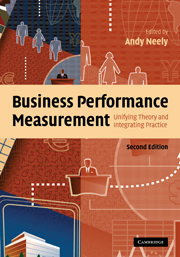Book contents
- Frontmatter
- Contents
- List of figures
- List of tables
- List of boxes
- List of contributors
- Introduction
- Part I Performance measurement – functional analyses and theoretical foundations
- Part II Performance measurement – frameworks and methodologies
- Part III Performance measurement – practicalities and challenges
- 11 Choosing marketing dashboard metrics
- 12 Risk in performance measurement
- 13 Measuring knowledge work
- 14 Measuring innovation performance
- 15 Context-based measurement
- Part IV Performance measurement in public services
- Part V Performance measurement – emerging issues and enduring questions
- Index
- References
15 - Context-based measurement
Published online by Cambridge University Press: 22 September 2009
- Frontmatter
- Contents
- List of figures
- List of tables
- List of boxes
- List of contributors
- Introduction
- Part I Performance measurement – functional analyses and theoretical foundations
- Part II Performance measurement – frameworks and methodologies
- Part III Performance measurement – practicalities and challenges
- 11 Choosing marketing dashboard metrics
- 12 Risk in performance measurement
- 13 Measuring knowledge work
- 14 Measuring innovation performance
- 15 Context-based measurement
- Part IV Performance measurement in public services
- Part V Performance measurement – emerging issues and enduring questions
- Index
- References
Summary
Introduction
This chapter introduces a method for collecting performance data in context. The method, termed Context-based Measurement (CbM), preserves a rich description of the circumstances of a measure. This contextual information is often overlooked, but essential in preserving the meaning of measurement information.
The principle of CbM can be explained using the metaphor of the Global Positioning System (GPS). In aircraft navigation, for example, a GPS receiver derives the speed and direction of an aircraft by recording over time the coordinates of longitude, latitude and altitude. This contextual data is then used to derive the distance to the destination, communicate progress to date and calculate the optimum flight path.
Now imagine if we had an equivalent of the Global Positioning System for the measurement of organizations. The coordinates of longitude, latitude and altitude might be replaced by ones of resource used, process performed and product produced. If we designed a GPS for an organization, we could measure its performance (e.g. cost or quality) in the context of the resource used, the process performed and the product delivered. Such an approach could help us specify our targets, communicate our performance and signal our strategy. This is context-based measurement.
The remainder of this chapter explains the method of CbM in more detail using a case study in the automotive industry. The reader should note, however, that the principles are not specific to an industry or discipline. We start by explaining how structures are essential to understanding in any form of measurement.
- Type
- Chapter
- Information
- Business Performance MeasurementUnifying Theory and Integrating Practice, pp. 318 - 336Publisher: Cambridge University PressPrint publication year: 2007



